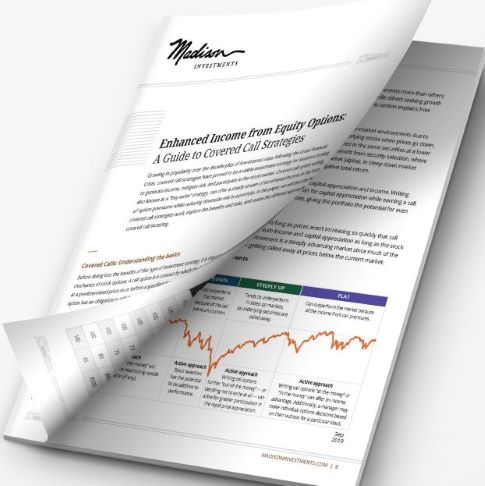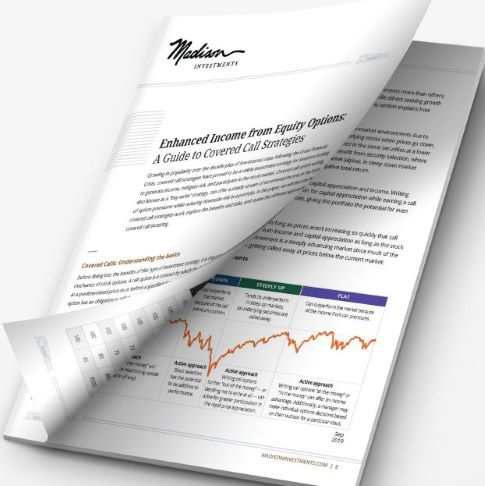
A covered call strategy is a defensive investment approach that has grown in popularity in recent years. By strategically combining the purchase of an underlying security with the sale of a call option, covered calls, also known as “buy-write” methods, have garnered attention for their unique ability to provide steady income while partially mitigating downside equity risks.
Our comprehensive white paper discusses how covered calls work, the benefits and considerations of actively managed strategies, their performance in varying markets, and more.
The Basics: Covered Calls
To fully grasp the benefits of this investment strategy, it’s crucial to understand the mechanics of stock options. A call option, a fundamental concept in this strategy, grants the buyer the right to acquire a security at a predetermined price (known as the strike price) on or before a specified date.
As for the seller of the call option, they assume the obligation to sell the underlying security to the contract owner at the stated strike price. In return, the seller (also known as the writer) receives a premium. Another type of option contract is a put option. Unlike call options, put options give buyers the right to sell an underlying security at a predetermined price within a specified timeframe.
Investors engage in the buying and selling of call and put option contracts for various purposes. Some seek to capitalize on projected price movements, while others are attracted to premium income or portfolio risk-dampening qualities.
Selling Call Options for Premium Income
If the underlying stock’s price reaches or exceeds the strike price, the writer becomes obligated to sell the stock at the predetermined price should the buyer exercise the option or allow for automatic exercise. This situation benefits the buyer, as they potentially acquire the stock at a discounted rate. In this scenario, the writer sacrifices the potential upside beyond the strike price in exchange for the premium generated from the option’s sale.
The optimal scenario for the call option writer is for the underlying stock’s price to appreciate, but not exceed the strike price before the expiration date.
What is a Covered Call Strategy?
A covered call strategy owns underlying assets, such as shares of a publicly traded company, while selling (or writing) call options on the same assets. Selling call options produces a stream of cash flow for the portfolio. This income can act as a source of yield for the investor or be reinvested to help offset losses in a market decline. Adding to the appeal for income-seeking investors is the possibility of dividends and potential capital gains generated from portfolio activity, distributed regularly.
From a risk and return perspective, covered call strategies tend to perform in line with the S&P 500® during periods of steadily up, declining, or flat markets, and lag when the market rises rapidly. All with less volatility, as measured by standard deviation. Over long periods of time and spanning all types of markets, covered call strategies offer a balance of market participation, risk mitigation, and income generation.
Covered Call White Paper
Enhanced Income from Equity Options: A Guide to Covered Call Strategies
Discover how this strategy can optimize your returns and navigate market fluctuations effectively. In this white paper, you’ll learn:
- The basics of covered calls
- Calculating the return of covered calls
- How a covered call strategy offers diversification
- Performance patterns in various market cycles
- Aligning this approach with investor objectives
- Types of covered call strategies
- Defining yield and distributions
- And more

Download our Covered Call White Paper
"*" indicates required fields
Disclosures
S&P 500® is an unmanaged index of large companies and is widely regarded as a standard for measuring large-cap and mid-cap U.S. stock-market performance. Results assume the reinvestment of all capital gain and dividend distributions. An investment cannot be made directly into an index.
The writer of a covered call option forgoes, during the option’s life, the opportunity to profit from increases in the market value of the security covering the call option above the sum of the premium and the strike price of the call, but has retained the risk of loss should the price of the underlying security decline.
Equity risk is the risk that securities held by the fund will fluctuate in value due to general market or economic conditions, perceptions regarding the industries in which the issuers of securities participate, and the particular circumstances and performance of the companies. In addition, while broad market measures of common stocks have historically generated higher average returns than fixed income securities, common stocks have also experienced significantly more volatility in those returns.
An investment in the Madison Covered Call and Equity Income Fund or the Madison Covered Call ETF is subject to risk and there can be no assurance the Fund will achieve its investment objective. The risks associated with an investment in the Fund can increase during times of significant market volatility. The principal risks of investing in the Fund include option risk, tax risk, derivatives risk, concentration risk, equity risk, mid cap risk, and market risk.
The preceding examples are based on American-style options. Other variations exist.
Diversification does not assure a profit or protect against loss in a declining market.
Although the information in this report has been obtained from sources that the firm believes to be reliable, we do not guarantee its accuracy, and any such information may be incomplete or condensed. All opinions included in the report constitute the authors’ judgment as of the date of this report and are subject to change without notice. This report is for informational purposes only and is not intended as an offer or solicitation with respect to the purchase or sale of any security.
For more information on options and related risks, contact your financial advisor and review the Options Clearing Corporation “Characteristics and Risks of Standardized Options” available at www.theocc.com.
| Definitions | |
|---|---|
| Option | The right to buy or sell a specified amount or value of a particular underlying interest (or security) at a fixed exercise price by exercising the option on or before its specified expiration date. |
| Call option | An option that gives the right to buy an underlying security. |
| Put option | An option that gives the right to sell an underlying security. |
| Strike price | Price at which the option holder has the right to purchase or sell the underlying security. |
| Premium | The price that the holder of an option pays and the writer of an option receives for the rights conveyed by the option. It is the price set by the holder and writer, or their brokers or the overall market, in a transaction in an options market where the option is traded. It is not a standardized term of the option and does not constitute a “down payment.” |
| Exercise | The holder of an option wishes to buy (in the case of a call) or sell (in the case of a put) the underlying security at the exercise price. |
| Expiration Date | The date on which the option expires. If an option has not been exercised before its expiration, it ceases to exist — that is, the option holder no longer has any rights, and the option no longer has any value. An American option may be exercised at any time before the expiration date, while a European option may only be exercised on the expiration date. |
| Long and Short | The word Long refers to a person’s position as the holder of an option, and the word Short refers to a person’s position as the writer of an option. |
| At the money | The current market value of the underlying security is the same as the exercise price of the option. |
| In the money | The current market value of the underlying security is above (call options) or below (put options) the exercise price of the option. |
| Out of the money | The current market value of the underlying security is below (call options) or above (put options) the exercise price of the option. |
| Standard Deviation | A statistical measurement of dispersion about an average, which, for a portfolio, depicts how widely the returns varied over a certain period of time. Investors may use the standard deviation of historical performance to understand the range of returns for a portfolio. When a portfolio has a higher standard deviation than its benchmark, it implies higher relative volatility. Standard deviation has been calculated using the trailing monthly total returns for the appropriate time period. The standard deviation values are annualized. |